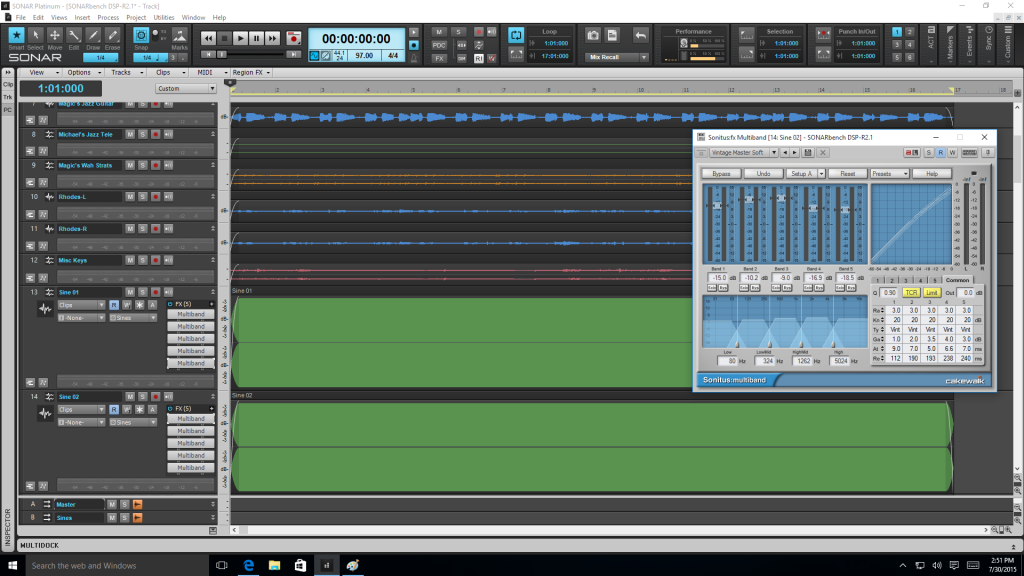We wanted to do some simple benchmarks to find out how running SONAR under Windows 10 compared to Windows 8.1. We did our tests on a moderately powered system using a basic audio interface (TASCAM’s US-322, the predecessor to the new US-2×2 and US-4×4 interfaces) set to 286 samples on input and 287 samples on output, for a total of 573 samples / 13 ms.
The SONARBench Project
This test project is useful to run not only because it provides information about SONAR’s performance, but also gives us a 1:1 basis for comparison with results reported by users in the field. The test project includes a 12-track mix of a band plus several additional tracks with only a sine wave. Each track includes five instances of the Sonitus Multiband compressor that are initially bypassed. We enable one Sonitus plug-in at a time until the CPU is taxed enough to cause audible “glitches,” and then notate the maximum number of enabled Sonitus plug-ins that SONAR can play once through without audible glitches.
The test continues by enabling more and more instances of the Sonitus Multiband until the audio engine drops out so we can note the maximum number of enabled plug-ins that allow SONAR to play without dropping out.
Test 1: Number of Sonitus Multiband plug-ins that can be inserted in audio tracks before glitching occurs.
Win 10: 203
Win 8.1: 179
Windows 10 is the clear winner here.
Test 2: Number of plug-ins that can be inserted before SONAR drops out.
Win 10: 362
Win 8.1: 362
For this test, there’s no difference in performance.
The DAWBench Project
This benchmark is similar to SONARBench, but uses plug-ins that other DAWs would be able to use (in this case, the CA-2A T-Type Leveling Amplifier running as a VST3 plug-in). This test also includes a 12-track mix of a band plus several tracks with a sine wave, and CA-2A instances are enabled one per track at a time until each track has one active CA-2A. We then repeat this until all tracks have a second CA-2A enabled or the audible glitches return, at which point we note the maximum number of active plug-ins that can be enabled without audio glitches.
Like the first benchmark, additional CA-2A instances are enabled until the audio engine drops out completely. We then note the maximum number of plug-ins that can play twice through the audio loop without a dropout.
Test 1: Number of plug-ins (CA-2A VST3) that can be inserted before before glitching occurs.
Win 10: 50
Win 8.1: 52
Statistically, the results are essentially equal; the discrepancy is likely attributable to jitter.
Test 2: Number of plug-ins (CA-2A VST3) before dropout.
Win 10: 103
Win 8.1: 85
Windows 10 is the clear winner here.



3 Replies to “SONAR Performance Benchmarks with Windows 10”
Comments are closed.